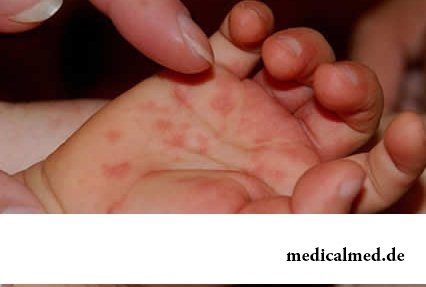





Enteroviral infection
Reference information

The enteroviral infection is understood as the acute diseases of digestive tract caused by enteroviruses. At the moment more than 60 types of causative agents of an enteroviral infection are known. All of them are subdivided into 4 groups depending on a serotype. The most often enteroviral infection is provoked by activity of viruses of Koksaki and poliomyelitis. Danger of an enteroviral infection is that its activators differ in extremely high resistance to action of aggressive environmental factors. They can remain long time in the wet soil and water, getting then into a human body through a city water supply system or the infected food stuffs.
At the beginning of 2008 in China the large-scale enteroviral infection at children was recorded. It was caused by the EV71 virus which did not prove within the last several decades. It gets into an organism through a mucous membrane of a digestive tract or upper airways, and then is carried on other bodies through circulatory system, affecting, among other, lungs and a brain. The enteroviral infection was revealed more than at 15000 children, 20 of them died. This fact reminds us once again that at the diagnosis an enteroviral infection treatment has to be carried out immediately and have complex character.
Ways of infection
Causative agents of an enteroviral infection get to external environment from an intestinal path and a nasopharynx that defines the main ways of infection: airborne, water, food, contact and household. The role of separate factors in the mechanism of transfer is up to the end not clear therefore terms of an incubation interval can vary depending on a condition of immune system of the person, characteristics of a specific type of a virus and conditions of an environment. As a rule, the enteroviral infection proceeds rather easily and does not lead to any serious complications. Nevertheless, the started forms of an enteroviral infection strike the most different bodies and systems, provoke development of a serious illness, in certain cases come to an end with a lethal outcome that we, actually, also observed during the Chinese epidemic.
Symptoms of an enteroviral infection
After the termination of an incubation interval patients have first alarming symptoms of an enteroviral infection:
- fever;
- headache;
- pains in belly area;
- podtashnivaniye, sometimes vomiting.
These symptoms of an enteroviral infection are expressed poorly, and in certain cases the infection does not prove at all. More serious signs are observed only after hit of activators in circulatory system and their distribution on the vital systems of an organism. From this point patients begin to complain on:
- fervescence;
- emergence of rash on hands and legs;
- hypostases of extremities;
- ulcers in an oral cavity.
If the enteroviral infection continues to develop further, and the patient does not undertake any measures to get rid of it, business can reach serious complications: meningitis, encephalitis, fluid lungs and even paralysis. The started enteroviral infection at children and adults leads to death or considerable damages of a brain and disability.
In recent years at children the so-called small enteroviral infection even more often comes to light. It is characterized by slight fever, weakness, muscular pains and usually passes by itself in 2-3 days, without causing the expressed changes from separate bodies.
Diagnosis of a disease
The enteroviral infection at adults is established only on the basis of results of laboratory researches. On their carrying out some time and for this term of the patient is required it is desirable to isolate from other family members. Due to the bystry spread of an infection each case of infection is subject to registration. Unplanned examinations of people which contacted to the patient are at the same time conducted. If during the researches the diagnosis an enteroviral infection was confirmed, symptoms and clinical disease are reflected in the separate card of epidemiological investigation.
Treatment of an enteroviral infection

Now specific methods of treatment of an enteroviral infection do not exist. In the acute period to patients the bed rest, a vitamin-rich diet, plentiful drink is appointed (vomiting and diarrhea can cause organism dehydration). If the enteroviral infection at children is followed by high temperature, and also severe head and muscular pains, then analgetics and antipyretics are recommended to the patient. At diarrhea it is reasonable to be used drugs for recovery of water-salt balance, for example, регидрон. Antibiotics are applied only in cases of accession of consecutive bacterial infections.
The developed diet have to answer the condition following:
- the products strengthening an intestines peristaltics are excluded from a diet (sweet, carbonated drinks, smoked products, black bread, fresh vegetables and fruit, fat and fried dishes);
- food has to be digestible;
- it is desirable to refuse the use of dairy products completely;
- if the enteroviral infection at adults and children is followed by putrefactive processes, patients need to eat baked apples which absorb toxic agents;
- it is the best of all to give food often, but in the small portions. It concerns both adults, and children.
Prevention of an enteroviral infection is directed to sanitary improvement of sources of fresh water, observance of rules of personal hygiene, disinfecting of sewage, providing the population with fresh, qualitative food stuffs and clear drinking water.
Scientists from the Oxford university conducted a number of researches during which they came to a conclusion that vegetarianism can be harmful to a human brain as leads to decrease in its weight. Therefore scientists recommend not to exclude completely from the diet fish and meat.

The varicosity has familiarly many, statistically, this disease more than a half of all adult population. As...
Section: Articles about health
The winter swimming in open reservoirs called in our country by "winter swimming" – officially recognized sport and one of the most extreme ways of a hardening of an organism. This occupation has an old story and adherents in many countries. Are annually carried out...
Section: Articles about health
The words "disease" and "patient" not without reason come from one root – "pain". As a rule, symptoms of illnesses thoroughly spoil to patients life. However from this rule there are exceptions. Some diseases are shown by signs which can cause even positive emotions. It is a pity only that the majority of such illnesses are heavy and incurable....
Section: Articles about health
Life of the modern woman is very difficult. Opportunities to realize itself are wide: it not only education and career, but also most differently...
Section: Articles about health
Summer in the heat. Many are going to spend vacation abroad. Travelers the tender seas, rest on beaches wait, for sightseeing, campaigns on natural and cultural reserves. But, unfortunately, on vacation also problems about health can wait for us...
Section: Articles about health
80% of women at least once to lives complained of discomfortable feelings to breasts, consolidations and nagrubaniye. These are mastopathy symptoms. The mastopathy is characterized by change of a ratio between ferruterous and connective tissue tissues of mammary glands. It can lead to formation of cysts (a cystous mastopathy), gland consolidation (a fibrous mastopathy), or a combination of these processes (a fibrous and cystous mastopathy)....
Section: Articles about health
Many of us, probably, noticed more than once that from intellectual loadings at some point the brain as though "overheats" also "assimilation"...
Section: Articles about health
All like to sing. Small children with pleasure are engaged in a vocal, not especially thinking of hit in a melody. Adults most often hesitate, being afraid to show lack of talents in this area, and it is vain: singing is very useful for health....
Section: Articles about health
Statistically cystitis 25-30% of women up to 40 years have. With age this indicator raises, besides many do not get to statistics because do not see a doctor. The most sad that after the regular visits to doctors, long reception of antibiotics and life in the mode "it is necessary to take care" cystitis all the same is returned to a half of women. Symptoms of cystitis are unambiguous and it is impossible to confuse them with anything: bladder pain, burning at an urination, frequent desires to go to a toilet, a vynuzhd...
Section: Articles about health
Sugar - the digestible refined product which is not of special value for an organism of the modern person. Use...
Section: Articles about health
Epilepsy is one of widespread neurologic diseases. Parents, whose children suffer from this illness, should face rumors and delusions, many of which remained since the Middle Ages....
Section: Articles about health
Aspirin (acetylsalicylic acid) – one of those drugs which are known literally to all. It is available in each home first-aid kit, and many accept it at the first signs of an indisposition, often without having a fair idea of properties and therapeutic effect of drug. Meanwhile, impact of aspirin on a human body is very various, and is not always favorable. About it it is important to foreknow, in order to avoid emergence of problems with health....
Section: Articles about health
The healthy nutrition is the invariable principle of health and good health for long years of the woman. Nevertheless, in рацио...
Section: Articles about health
Aging — natural and inevitable process. Over time our skin loses elasticity, on it saggings are formed, the face form loses former clearness. The procedure of nitevy lifting (nitevy tightening) can successfully solve this problem. In order that it is better познако...
Section: Articles about health
An eye of the person daily experiences considerable strain. The problem of preservation of sight is for many years directly connected with a question of supply of tissues of eye enough oxygen and nutrients. This task is carried out by small vessels – capillaries. For normal functioning of the visual device extremely important that they kept the integrity, but it works well not always. Microtraumas of eye vessels during which there are small hemorrhages it is extraordinary расп...
Section: Articles about health
Impossibility to conceive the child – a trouble of many Russian families. During quite long time was considered that the main "culprits...
Section: Articles about health
Life expectancy in various regions of Earth is not identical. Social stability, economic wellbeing, availability and level of medical care, household comfort, literacy of the population in the field of observance sanitary гигиен exert impact on it...
Section: Articles about health
Osteoporosis this general disease which main sign is decrease in density of a bone tissue. On distribution width it takes the fourth place among noninfectious diseases. The illness develops at mature age more often: in our country about a third of women and a quarter of men suffers from it 50 years are more senior....
Section: Articles about health
For anybody not a secret that the modern person eats not as his ancestors. For the last 100 years in broad access appeared with...
Section: Articles about health
There comes the season of issues. Many Russians already dream of outdoor recreation, trips, beautiful seaside beaches. At this time there is no wish to think of problems with health and other unpleasant things, however there are subjects which require attention. Summer...
Section: Articles about health
Statistically, pathologies of a thyroid gland in the world more than 500 million people have. Failures in work of this body lead to heavy disbolism, development of heart diseases, vessels, a reproductive and nervous system. In hard cases excess or insufficient production of the main hormones of a thyroid gland (thyroxine and triiodothyronine) leads to essential decline in quality of life and disability....
Section: Articles about health
It is difficult to revaluate importance of kidneys for an organism. These bodies not only perform work on purification of blood of decomposition products and выв...
Section: Articles about health
Each of us repeatedly noticed that the people having the same passport age are sometimes not similar on one-years at all. One at the age of 40-45 years already looks almost an old man, and another and in 60 is young, vigorous and full of life. The matter is that state нашег...
Section: Articles about health
History of use of an anesthesia during operations contains more than 160 years. Annually in the world hundreds of thousands of surgical interventions during which to patients the substances immersing them in a dream and saving from pain are entered are carried out. Using an anesthesia many myths and delusions are still connected. It is worth getting acquainted with the most widespread of them....
Section: Articles about health
Tea is loved and use almost everything. This drink has tonic properties, contains the tannins capable podavlit...
Section: Articles about health
All of us, unfortunately, should face flu nearly an every year. It would seem, so frequent disease has to be studied already up and down, and each person, at least once by it had (and the number of such people in our country aims at 100%), a dolzha...
Section: Articles about health
Dark circles (bruises) under eyes – a shortcoming with most of which often fight against the help of cosmetics (proofreaders, saloon procedures and so forth), eliminating only its visibility. However, according to doctors, skin around eyes – the indicator of many disturbances in an organism. To reveal them at early stages, without having disguised bruise, and having addressed its reasons – a task of each person who is regularly finding under with own eyes dark stains. Early detection and elimination of the disease lying in wasps...
Section: Articles about health
